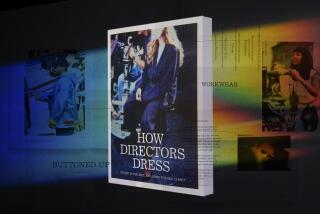Spring Choices in Menswear Run the Gamut
- Share via
Two well-known designers of menswear express varying opinions on what’s right today in the following interviews reported by Fashion85 staff writers Betty Goodwin and Mary Rourke.
During his honeymoon last fall on the Caribbean island of St. Martin, Lee Wright sunbathed in men’s cotton underwear.
Not just any underwear, you understand, but fuchsia bikini underwear, which Wright designed himself, using his own body, as he puts it, as “a barometer of comfort.”
As Wright tells the story, nobody on the beach blinked an eye at his makeshift swimsuit, which proved to him that his creation had possibilities beyond the ordinary brief.
Wright was right.
The bikinis, along with an array of other useful items, are now selling at J. C. Penney, which is another unusual twist to the story.
Winner of Coty Award
Wright is not just any designer. In the world of men’s fashion, he stands on that rare plateau reserved for those who have won the industry’s Coty Award. Until recently, his clothes were available only at tony men’s shops. But in a move that he feels marks his new populism, he has taken his talents to the mass market.
In 1983, Wright closed his own manufacturing company and joined Halston at J. C. Penney as one of the prestigious designers making clothes at reasonable prices. His shirts and slacks sell for about $30; sport coats, $150; suits, which are now being made in Italy, are between $200 and $225.
Like the fuchsia bikini underwear, Wright considers everything in the line progressive rather than predictable. Suit shoulders are big; pants, baggy; sweaters, graphic. The colors, in a word, are what he calls moody . Indeed, the moodier the colors, he believes, the faster they sell. Plaid shirts come in combinations such as mauve and teal or plum and brass.
Furthermore, Wright describes his agreement with J. C. Penney as like having a “rich supportive parent,” adding that he has no desire to return to the world of “elitist” fashion.
‘A Designer’s Dream’
“It’s a designer’s dream,” Wright explains. “You do your work and don’t worry about paying the bills. A buyer calls me up and says: ‘Are you interested in doing umbrellas?’ Now I’m working on umbrellas. And the best thing I have going for me is that I get to create any fabric I want because of the volume we do.”
The idea of “making a difference” by dressing millions of people rather than by selling $500 sport coats to a small group of people is what appeals to him most.
“People today are looking for values and fashion at the same time,” he says.
More to Read
The biggest entertainment stories
Get our big stories about Hollywood, film, television, music, arts, culture and more right in your inbox as soon as they publish.
You may occasionally receive promotional content from the Los Angeles Times.










